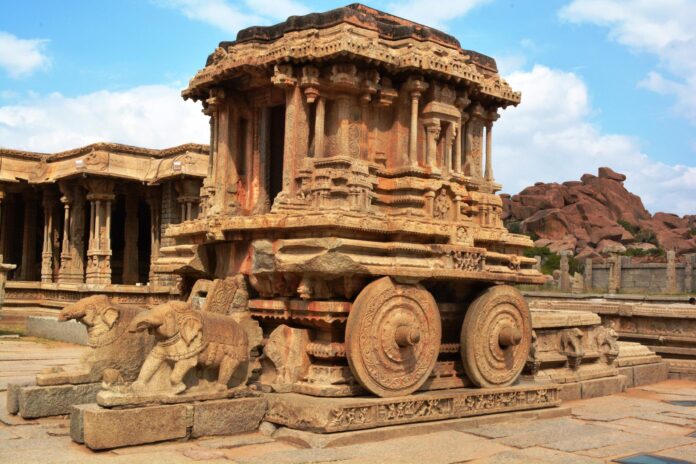A very powerful and fun empire is part of the memory and culture of the people of India. His name is Vijayanagara.
There are many empires, their legacies and assets are still visible today. These are part of our memories, customs, beliefs and other fashions and lifestyles. Our legacy and the heritage that we have inherited from our ancestors is our identity. Who we are today is because of our history and the ways of life of our ancestors.
The first capital of this empire was also called Vijayanagara. But according to respected sources, we come to more names like Vidyanagar, Biznaga, Bisnegalia, Pampakshtra, Virupakshapura etc.
These names are very important to understand the culture and ideologies prevailing during the 13th-15th centuries in India.
Vidyanagar probably originated from a religious man there named Vidyanranya. He was a man of Lord Shiva who assisted the Kings of Vijayanagara Harihara and Bukka. The name Pampakshetra was also used indicating that the city was located next to the Pampa River. Pampa still flows today through the town of Vijayanagara or Hampi. Hence the name used today to name the ruins is Vijayanagara. Pampa is also a goddess in Hampi.
According to numerous authors, Hampi is a word that has its origin Pampa. Also, Virupakshapura is a name that originates from a great temple of the god Virupaksha, an avatar of God Shiva. Still every year many pilgrims visit this temple to pray.
Pampa today is considered to be a wife of Virupaksha, whose name is used to name the god who has the third eye on his forehead. Another name for this place is Pampapatikshetra, as a place owned by Pampa’s husband.
Other names such as Biznaga and Bisnegalia were used by visitors from Portugal, Italy, Russia and Iran who came to those lands.
We are going to start talking about India and Central Asia in the historical context or setting during the 11th to 13th centuries. Around the X or XI the Crusades had ended with the victory of the Saracens against the forces of Europe.
Following the reasons mentioned above, from the tip of the cape to South Asia, the Islamic empires had begun.
There was a lot of competition between different tribes. Many tribes in Asia had converted to Islam such as the Seljuks, Turks, Mongols, etc. These tribes were warrior nomads and were highly skilled at archery on horseback.
Because of a lot of competition between the Central and Western Asian tribes, some tribes took the risk of going to the Indian subcontinent. At first, some tribes came in to take the riches and spoils of the North Indian empires. But over the years these tribes replaced the local empires and started new empires like the Delhi Sultanate, the Bengal Sultanate, or the Bahamani Sultanate.

According to colonial historians, this was a period of the Islamization of India.
But these thoughts lack firm support. These centuries are very controversial for scholars around the world. Still today there is not much evidence to deny or confirm this matter.
Other names such as Biznaga and Bisnegalia were used by visitors from Portugal, Italy, Russia and Iran who came to those lands.
The Vijayanagara study is a good case study to investigate. The foundation of the Vijayanagara empire was based on the novelties already mentioned.
At first, the Sultanates that ruled North and South India in the Vindhyas hills were local empires like the Yadavas in Maharashtra, Hoysalas in Karnataka, Kakatiyas in Telengana, Andhra Pradesh and finally Pandyas in Tamilnadu.
According to new scholars, the sultanates came from the Persian culture. As were their languages, customs, food, clothing, sports, etc.
Instead in the southern Vindhyas, the empires followed the norms instructed in the Sanskrit texts such as the Vedas, Puranas and others. People there pray to brahmanical gods and goddesses like Shiva, Vishnu, Durga and many more. The architecture of those empires was conducted according to the texts of Vastu and Shilpa Shastras. The kings upheld the Varnashram Dharma, this is the stratification of society around the norms of Rig Veda.
According to some academics, the way of life was governed by the Persian culture. And according to others, the Middle Ages in India were the times of clashes between the Persian and Sanskrit civilizations.
Now, we will focus on the city of Vijayanagara, in the present known as the small town of Hampi. It is situated beside the Tungabhadra River. This riverbed is called Pampa, after the aforementioned goddess. The ruins of Hampi include temples, mosques, palaces, a large trima, elephant stables, forts etc.
In the beginning, the Sultanates that ruled North and South India in the hills of Vindhyas were local empires like the Yadavas in Maharashtra.
These ruins are like a paradise for architects, archaeologists, artists, historians etc. It is a place with many wonderful landscapes. And also a UNESCO World Heritage Site.
Hampi is located in Bellary, a district of the state of Karnataka, in southern India. The nearest airport is in the city of Hubbli, Bangalore, which has a large international airport. The nearest train station is in the municipality of Hospet. There are expressways connecting Hampi with big cities like Hubbali, Bangalore, Hyderabad and Mumbai. There are many hotels in Hospet, Kamalapuram and Bellary, both luxurious and cheap.

Scholars have separated the metropolis of Hampi into four geographical zones. These are the sacred center, the irrigated valley, the urban core and the suburban territory on the outskirts of the metropolis.
The Sacred Center is located on the southern shore of Pampa. Many temples can be seen and explored there, such as the famous temples to the god Virupaksha, the temple to the god Vitthal and the temple to the god Tiruvengalnath. There are other great monoliths of Ganesha, Lakshmi Narasimha, Nandi and Badavi Linga.
Exploring the interiors of Hampi, a large urban core can be seen. Between the Sacred Center and the urban core there is an irrigated valley and the entire road where farmers grow bananas and rice paddies.
This urban nucleus is surrounded by a fortification. The streets extend in cardinal directions. There you can find the great temple of Ramchandra along with other small temples of different gods and goddesses. There is a large trima, elephant stables, an ornate well and some ruins that look like the King’s Palace.
The Middle Ages in India were the times of clashes between the Persian and Sanskrit civilizations.
In the suburban territory you can find many small towns inhabited by local populations. There are many temples in different towns like Pattabiram temple in Kamalapuram, Raghunath temple in Malyavanta hill, Anantashayana temple in Anantashayanagudi etc. And there is a good government museum in Kamalapuram too.
Vijayanagara was a very successful empire. He had trade relations with the Arabs and the Portuguese. He had four dynasties which are: Sangamas, Saluvas, Tuluvas and Aravidus. But Sangamas and Tuluvas were the kings with the ability to develop Vijayanagar into a global empire.

The society continues to believe in the Shastras. But in secular life, the cosmopolitan culture, its kings and its aristocracy, had adopted the Persian culture. Actually the kings and their aristocracy were Hindus and continued to believe in Sanskrit, but mixed their traditions. In their expansion process they used epithets like Sultan and adapted Persian fashion like the kullayi and kabayi. Indeed, Persian elements such as domes, arches, sculptures of Persian people, etc. can be seen in art and architecture.
The society and culture of India in the Middle Ages was very complex and no one can generalize whether it was an Islamic or Hindu culture, nor separate between idioms and cultural paradigms that were born in India during these centuries. We need to study all the periods and territories with different methodologies and with a holistic understanding to better understand what this empire was.













Add Comment